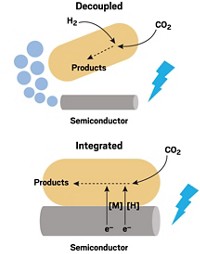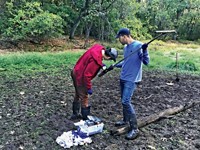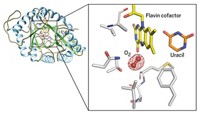Advertisement
Grab your lab coat. Let's get started
Welcome!
Welcome!
Create an account below to get 6 C&EN articles per month, receive newsletters and more - all free.
It seems this is your first time logging in online. Please enter the following information to continue.
As an ACS member you automatically get access to this site. All we need is few more details to create your reading experience.
Not you? Sign in with a different account.
Not you? Sign in with a different account.
ERROR 1
ERROR 1
ERROR 2
ERROR 2
ERROR 2
ERROR 2
ERROR 2
Password and Confirm password must match.
If you have an ACS member number, please enter it here so we can link this account to your membership. (optional)
ERROR 2
ACS values your privacy. By submitting your information, you are gaining access to C&EN and subscribing to our weekly newsletter. We use the information you provide to make your reading experience better, and we will never sell your data to third party members.
Biological Chemistry
Building Better Bacteria
Synthetic biologists turn to a microbe named Shewie to ‘wire’ microorganisms for fuel production, energy storage
by Lauren K. Wolf
April 25, 2011
| A version of this story appeared in
Volume 89, Issue 17

Biologists play with rats and mice, and microbiologists tinker with Escherichia coli. Researchers rely on the well-known genetic codes and physiologies of these model organisms to advance scientific knowledge and even make new products.
But there’s a new lab rat on the block. Shewanella oneidensis, a gram-negative bacterium capable of “breathing” metals in a way similar to how humans respire oxygen, has become a species popular with environmental microbiologists in recent years, says Kenneth H. Nealson, who discovered the organism in New York’s Oneida Lake, near Syracuse, in 1987. Shewie, as it is affectionately called by some of the scientists who study it, contains a chain of heme-bearing proteins that allow the microorganism to shuttle electrons from its inside to its outside during anaerobic respiration. In other words, feed it and S. oneidensis can directly transfer charge to and reduce external aqueous metals or solid metal oxides.
This inherent capability makes Shewie attractive to scientists developing microbial fuel cells, with biofilms of electrode-reducing bacteria consuming components of wastewater and generating electricity. Others want to use Shewie for soil remediation at sites contaminated with heavy metals or radioactive materials. For instance, researchers have shown that the microorganism can convert soluble uranium(VI) ions into insoluble, isolatable uranium dioxide nanoparticles (C&EN, Aug. 21, 2006, page 44).
But what really makes Shewie a model organism, explains Nealson, a University of Southern California geobiologist who has been studying metal-reducing bacteria for decades, is that it is harmless and has a fully sequenced genome. And although it thrives in an anaerobic environment, it also likes oxygen, making it easy to grow and use in the lab. These qualities have scientists—particularly synthetic biologists—working hard to understand the bacterium’s electron-transfer pathway and taking advantage of its metal-breathing capability to construct microorganisms that are even more useful.
Caroline M. Ajo-Franklin, for one, has her eye on Shewie’s respiratory pathway as a way to “wire” other types of microbes and cells for electronic communication. By enabling intracellular electrons to cross what in most cells are insulating outer membranes, says Ajo-Franklin, a synthetic biologist at Lawrence Berkeley National Laboratory, scientists could create living biosensors that give an electrical readout when exposed to small molecules. Similarly, researchers could transform light-sensitive organisms into photocatalysts, rigging them to route the electrons they generate into batteries for storage.
As a first step toward making these cell-electrode systems a reality, Ajo-Franklin and her team took a portion of Shewie’s electron-transfer pathway and, via genetic engineering, inserted it into E. coli (Proc. Natl. Acad. Sci. USA, DOI: 10.1073/pnas.1009645107). This synthetically “tricky” feat, the LBNL scientist says, involved adding three S. oneidensis proteins—MtrA, MtrB, and MtrC—to the outer membrane region of E. coli.
MtrA is a decaheme protein that accepts electrons from the inner workings of S. oneidensis cells. It resides in the space between the two cell membranes characteristic of gram-negative bacteria such as E. coli and Shewie. This protein passes along its charged cargo through the pore of MtrB, an integral protein embedded in the outermost of Shewie’s two membranes. MtrB facilitates the transport of the electrons to MtrC, another decaheme protein that sits outside the cell and can move the charge to electrodes or other aqueous species.
After some trials and tribulations, and with help from chemical biologists Yuri Y. Londer and Peter Weigele of New England Biolabs, in Ipswich, Mass., Ajo-Franklin’s team eventually inserted the Mtr pathway into E. coli. As a result, the E. coli was able to reduce iron oxide nanoparticles in solution. Although the engineered bacterium reduces the particles an order of magnitude more slowly than does native S. oneidensis, “we’ve made E. coli that can breathe rust,” Ajo-Franklin emphasizes. The accomplishment provides a “blueprint” for adding the electron-transfer functionality to other cells, she says, and leaves room for optimization.

The next step for Ajo-Franklin is to send the electrons from the engineered E. coli to an electrode. Her team is now exploring both physisorption—letting the bacteria attach themselves to the surface—and controlled immobilization to achieve that goal.
For the latter scheme, Ajo-Franklin is collaborating with chemists Matthew B. Francis, Carolyn R. Bertozzi, and Richard A. Mathies of the University of California, Berkeley.
The researchers recently developed a way to bring the cells close to an electrode surface by chemically attaching single-stranded DNA to the outside of mammalian cells via naturally occurring amine groups on their membranes (Lab Chip, DOI: 10.1039/b821690h). Complementary single strands of DNA anchored to an electrode hybridize with the cell-bound strands, bringing the cells close to the surface for electron transfer.
But the amine linker needed for mammalian-cell attachment won’t work for gram-negative bacteria because of their double cell membranes, Francis says. So the Berkeley researchers are concocting a new type of chemistry to link the DNA to their engineered E. coli. Ajo-Franklin hopes that this method will more efficiently route electrons to the surface because the DNA linkers should coax the engineered cells to bind to the electrode more tightly and densely than they would otherwise.
Rather than engineer bacteria to be a bit more like Shewie, Jeffrey A. Gralnick is trying to give Shewie some of the beneficial capabilities of other bacteria. “Using a native organism that already does something unique” has advantages, says Gralnick, a microbiologist at the University of Minnesota, Twin Cities, because “you don’t have to teach it the trick that you are really interested in”—in this case, Shewie’s ability to move electrons around.
Gralnick has been studying S. oneidensis with the ultimate goal of improving the efficiency of industrial reactions. Current bioconversion processes, in which microbes catalytically convert feedstocks into chemical products or fuels, often create unwanted side products because the cells don’t achieve redox balance, Gralnick says. But with bacteria like Shewie that can transfer electrons from the inside out, excess charge could be removed with an external electrode acting as a sink. “That way, you could stoichiometrically convert your substrate into your product,” he says.
Along with Daniel R. Bond, another microbiologist and a collaborator at Minnesota, Gralnick has recently demonstrated the concept, using electrode-adsorbed S. oneidensis to transform glycerol into ethanol (mBio, DOI: 10.1128/mBio.00190-10). Through genetic engineering, the researchers added to Shewie proteins and enzymes from other bacteria that would allow S. oneidensis to ingest glycerol, shuttle leftover electrons to its native electron-transfer pathway, and eject ethanol.
When the electrode that held the engineered S. oneidensis was poised at a voltage to accept electrons, the new-and-improved Shewie sucked in almost 33-mM glycerol and pumped out about 28-mM ethanol—an 85% carbon conversion. The engineered microorganism generated only a small amount of acetate by-product (15%), rather than the multiple by-products E. coli might yield from a similar bioconversion.
Reactions of this sort with Shewie could “in principle open up the landscape for new types of industrial bioreactions that maybe weren’t considered before because of redox imbalance,” Gralnick says, additionally citing glycerol-to-dihydroxyacetone conversion as an example. And although it’s not yet clear how to scale up this type of reaction for industrial-size fermenters, he says that the team he leads with Bond is working with engineers to figure out how to make it happen.
Despite his interest in applied work, Gralnick advises that researchers not forget the true beauty of engineering Shewie’s pathways and proteins into nonnative organisms: That tinkering can “help find out about how the bacterium actually works,” he says. Many things are still not known about Shewie, Gralnick adds. For instance, “there have been rumblings in the past year or so of X-ray crystal structures” of the Mtr proteins, he says, but nothing has been published yet. So researchers aren’t sure how the hemes in the electron-transfer pathway are oriented.
In addition, researchers are trying to understand how Shewie routes electrons from MtrC to metal species or electrodes over large distances (greater than 10 nm). Transfer still occurs when direct MtrC-metal contact is obstructed. Some scientists, including Gralnick, think that flavins, which S. oneidensis secretes, are an electron shuttle between bacterium and metal in solution (Proc. Natl. Acad. Sci. USA, DOI: 10.1073/pnas.0710525105). Others, including Nealson and physicist Mohamed El-Naggar, also at USC, have observed conductive nanowires growing from the outside of Shewie that could function like extendable arms, reaching out to transfer charge to other materials (Proc. Natl. Acad. Sci. USA, DOI: 10.1073/pnas.1004880107).
Ajo-Franklin might be able to answer some of these questions with her work, Gralnick says, because E. coli doesn’t inherently secrete flavins and presumably doesn’t grow nanowires. In optimizing electron-transfer efficiency in E. coli, she might also discover further details about the Mtr pathway, he adds with excitement. “Being able to show that the components that you’re looking at are not only necessary for a process but are also sufficient to reconstruct it is an important scientific achievement,” Gralnick contends.
Nealson is also confident that some of these unknowns will become clear in the next generation of studies with Shewie, the “bug” he discovered. “It is absolute fun to watch all the research activity,” he says. Young scientists such as Ajo-Franklin and Gralnick “are so good at what they are doing,” he adds, “I may have to look for another field.”






Join the conversation
Contact the reporter
Submit a Letter to the Editor for publication
Engage with us on Twitter